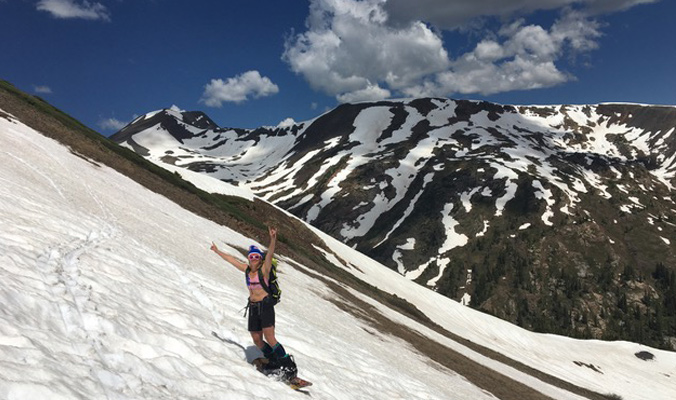It’s only midsummer, but the powder dreams are settling in each night. As the days grow shorter, trailers for new ski movies debut and you’re in the thick of researching next year’s gear, it’s also time to ask yourself how best to keep your skills sharp in preparation for the upcoming winter. Here are a few things to do during the warmer months to plan for the coming winter.

Keitha Kostyk checks out summer terrain near Crested Butte, Colo. [Photo] Steve Banks
Keep your head in the game and prepare for bigger bc missions by working on your navigation and tour-planning skills. Sure, following the blue dot on your phone is pretty easy with the right apps, but it’s important to know the basics of non-digital navigation incase your phone isn’t working. A local guide service or outfitter may offer orienteering courses, which can help you when using a GPS/map or compass—skills that are indispensable when skiing on glaciers or in the bigger ranges of the world.
If you’re already confident with analog orientation but want to stay sharp, try getting lost in a thick forest. A “greenout” is as good as a whiteout for working on your navigation techniques. Pre-plot a specific location like a notch, low pass or creek drainage and go find it off-trail. Learn how to triangulate your location by taking a compass bearing from three nearby peaks or landmarks and drawing lines on your map to find their intersection. And don’t forget about magnetic declination—the angle of difference between magnetic north (compass) and true north (map). This difference changes in each location around the world and is a key factor in accurate navigation.
And avalanche rescue skills shouldn’t be discarded with the snowmelt. Even without burying a transceiver, any practice is good practice for learning the details of how your beacon works. For more of a challenge, hide the beacon in a small box with other boxes scattered around the yard as well, or go into the woods and hang the sending beacon from a tree branch. The more complicated your search, the more opportunity there is to really get in tune with your beacons.
Learn the terrain
Summer is a good time to check out your usual stomping grounds. What does your favorite backcountry slope look like without snow on it? Check out the ground cover and how it could relate to potential wintertime avalanche releases. Is the slope grassy and planer or rocky and rough? Are there trees and stumps and logs and early-season hazards lying around? If there’s a booter you’ve been eyeing, check to make sure the landing is clear of lurking debris. Take some photos to reference later, and, to get a different perspective on avalanche destruction, head out to an area where you know a big slide let loose last winter. Seeing the snapped trees and even remaining piles of debris can be sobering.
Dial in your gear
When you finally hung up your skis last May, you took the time to clean your kit and prep it for next season, right? In case you forgot a couple things, here are some ideas:
- Put storage wax on your skis; a cheap, warm wax will do the trick. Just iron it in and leave it until the fall. This helps the P-Tex from drying out.
- Check your bindings. Is there excessive play or wiggle? Did you get those parts to fit your jerry-rigged fix?
- Clean skins: Warm water and a sponge will help clean out the pine needles and dog hair. Make sure the tip and tail clips are still in good order, and use the “cheat-sheets” for summer storage to keep the glue in good shape and prevent them from gumming up.
- Take the batteries out of your beacon. If batteries leak, your beacon is trashed. Don’t risk it!
- Check out your probe and shovel. Are all the necessary parts in place? Lube up the spring clips on your shovel for smooth action. Inspect it for any cracks. Check the cable or string of your probe to see if it is damaged at all. You don’t want these pieces failing when you need them the most.
- Blow off your airbag just for fun. It’s good to test it and see what it is like. You may be more likely to get that canister refilled sometime in the next three months if you’re frigging with it now.
Bottom Line: While summer may feel like a time for relaxation and rejuvenation from cold toes and tired hip flexors, it’s also a great time to use those extra hours of daylight to brush up on safety skills, explore your territory and sort your kit, so your next season is even better than the last.
—
Steve Banks is an IFMGA/AMGA mountain guide based in Crested Butte, Colo. He has been a professional ski patroller and a forecaster and director of the Crested Butte Avalanche Center and is currently an Instructor Team member for the AMGA.










Related posts:
Mountain Skills: The dos and don’ts of quick pits
The Art of the Up: Tips for Skinning Ease and Efficiency
Mountain Skills: Bruce Tremper on 20 years of education, safety and snow science
Mountain Skills: How to Overcome Avalanche Education Anxiety